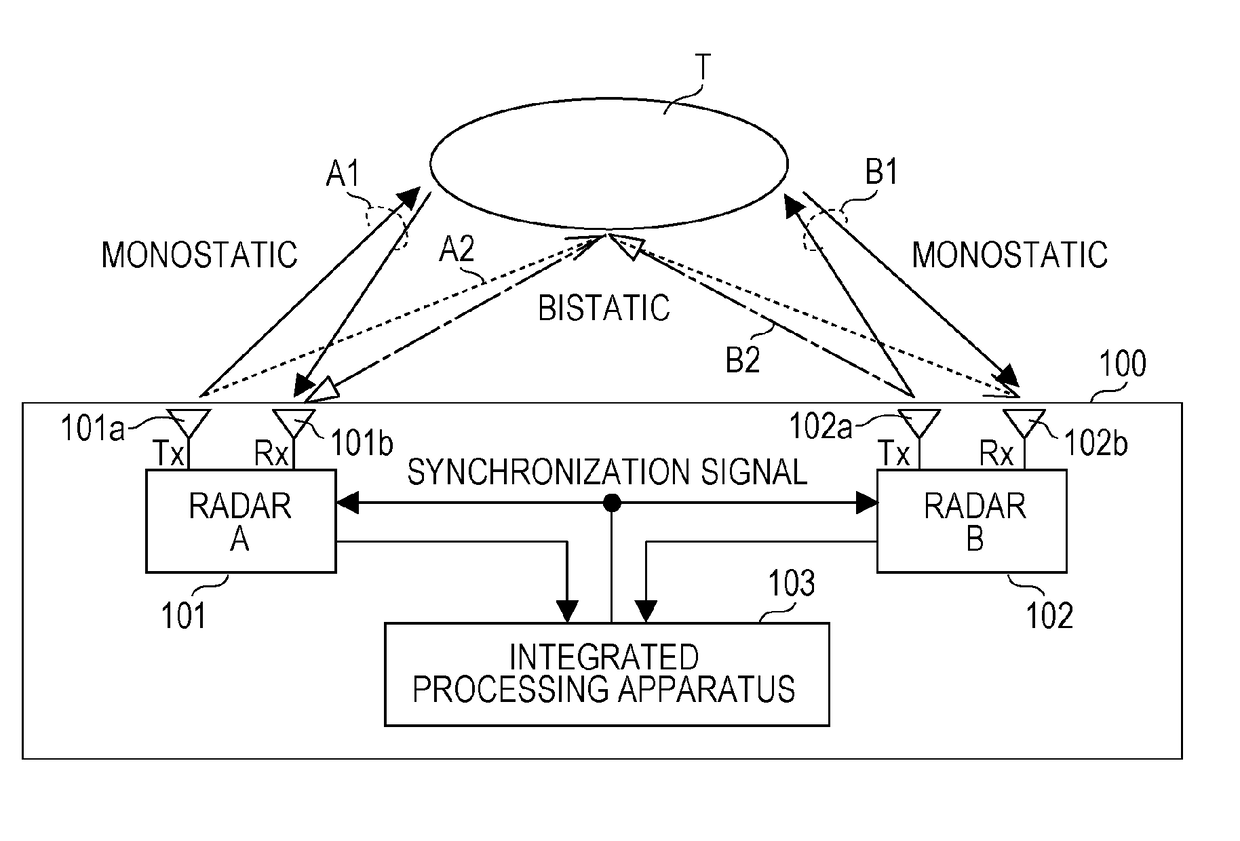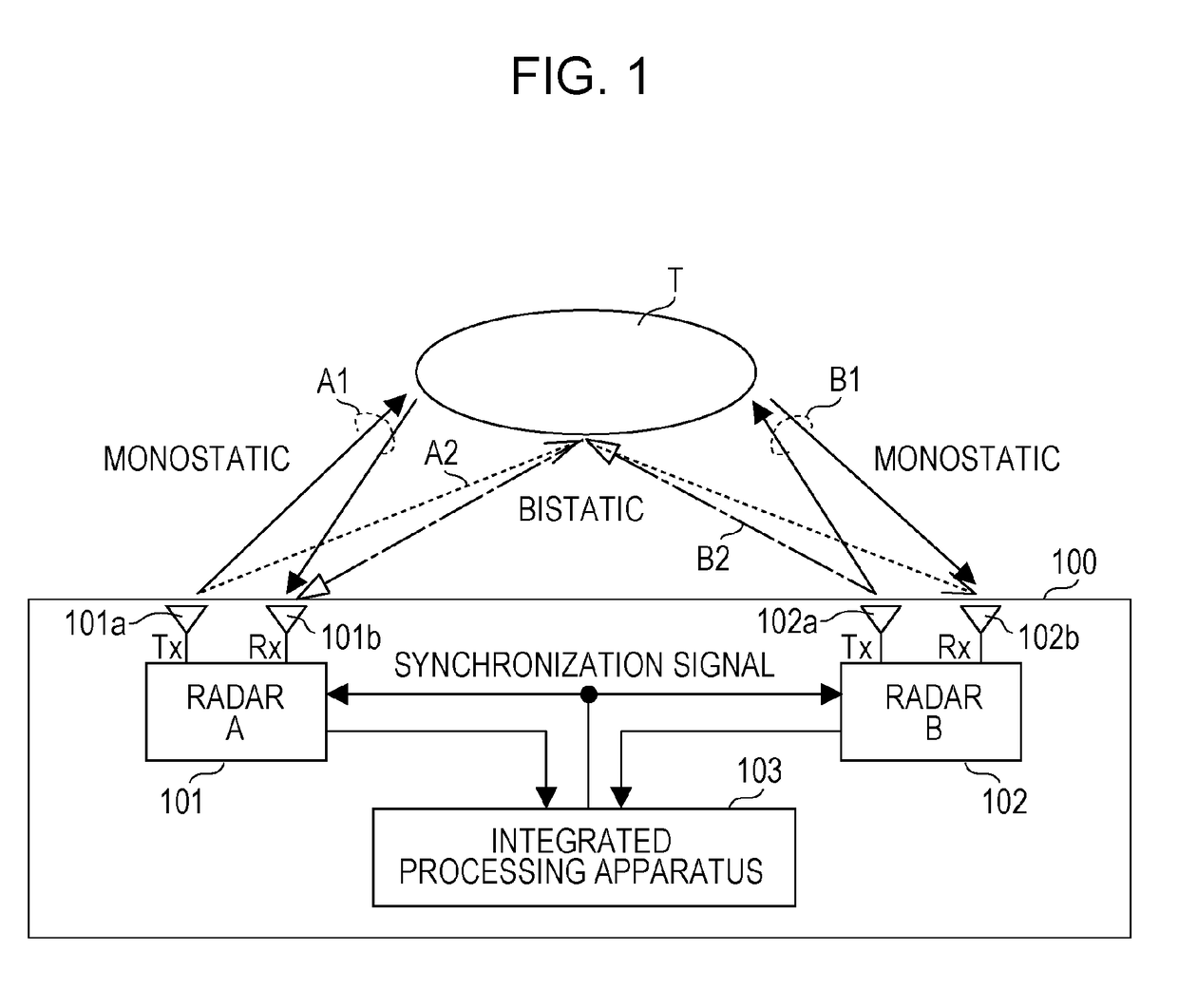Multi-radar system
a multi-radar and radar technology, applied in diversity/multi-antenna systems, instruments, using reradiation, etc., can solve problems such as failure to consider enhanced resolution, and achieve enhanced resolution and improved target detection performan
- Summary
- Abstract
- Description
- Claims
- Application Information
AI Technical Summary
Benefits of technology
Problems solved by technology
Method used
Image
Examples
embodiment 1
Relationship Between Target and Multi-Radar System
[0034]FIG. 1 schematically shows a relationship between a multi-radar system 100 according to a first embodiment of the present disclosure and a target T. As shown in FIG. 1, the multi-radar system 100 includes a radar A 101, a radar B 102, and an integrated processing apparatus 103.
[0035]The radar A 101 includes a transmitting antenna 101a and a receiving antenna 101b, and the radar B 102 includes a transmitting antenna 102a and a receiving antenna 102b. For reduction in size of the radar apparatuses, it is desirable that the transmitting antennas 101a and 102a and the receiving antennas 101b and 102b be located close to each other, respectively. For this reason, in the first embodiment, the transmitting antennas 101a and 102a and the receiving antennas 101b and 102b are placed, for example, at a distance of approximately 30λ or shorter from each other, respectively. It should be noted that λ is a wavelength that is determined by a ...
second embodiment
[0080]The first embodiment described above has described a case where the lines of sight of the radars A 101 and B 102 coincide with each other. A second embodiment described below describes a case where the lines of sight of the radars A 101 and B 102 do not coincide with each other.
[0081]FIG. 4 shows a block configuration of a multi-radar system 100a according to the second embodiment. As shown in FIG. 4, the multi-radar system 100a according to the second embodiment further includes a line-of-sight difference calculator 401, an other-radar position observer 402, a radar-B installation coordinate setter 403 in addition to the components of the multi-radar system 100 according to the first embodiment shown in FIG. 2.
[0082]The line-of-sight difference calculator 401 calculates shifts in the lines of sight of the radars A 101 and B 102 (a horizontal shift being hereinafter referred to as “θ”, a vertical shift being hereinafter referred to as “φ”). Shifts in the lines of sight may be ...
third embodiment
[0091]A multi-radar system 100b according to a third embodiment is configured to further include an average position calculator 501 as a further preferred example of the multi-radar system 100a according to the second embodiment. FIG. 5 shows a block configuration of the multi-radar system 100b according to the third embodiment.
[0092]The average position calculator 501 calculates an intensity-based average position on the basis of the positional information of the orthogonal coordinates of the radar A 101, the intensity vector of the radar A 101, the positional information of the orthogonal coordinates of the radar B 102, and the intensity vector of the radar B 102. Then, in a case where the output (intensity vector) from the phase synthesizer 241 is greater than the predetermined threshold, the threshold comparator 243 outputs the average position calculated by the average position calculator 501 to the position averager 245 as positional information. With this, in a case where rel...
PUM
 Login to View More
Login to View More Abstract
Description
Claims
Application Information
 Login to View More
Login to View More - R&D
- Intellectual Property
- Life Sciences
- Materials
- Tech Scout
- Unparalleled Data Quality
- Higher Quality Content
- 60% Fewer Hallucinations
Browse by: Latest US Patents, China's latest patents, Technical Efficacy Thesaurus, Application Domain, Technology Topic, Popular Technical Reports.
© 2025 PatSnap. All rights reserved.Legal|Privacy policy|Modern Slavery Act Transparency Statement|Sitemap|About US| Contact US: help@patsnap.com



